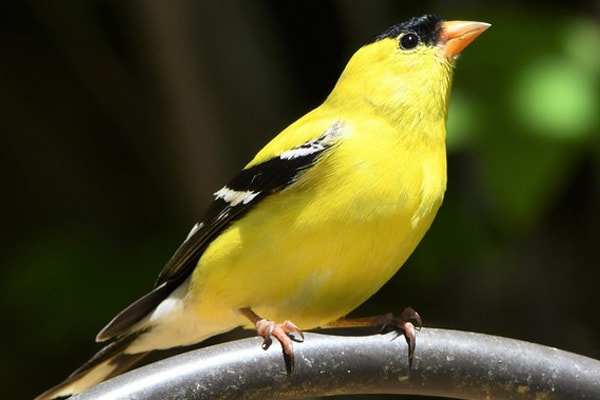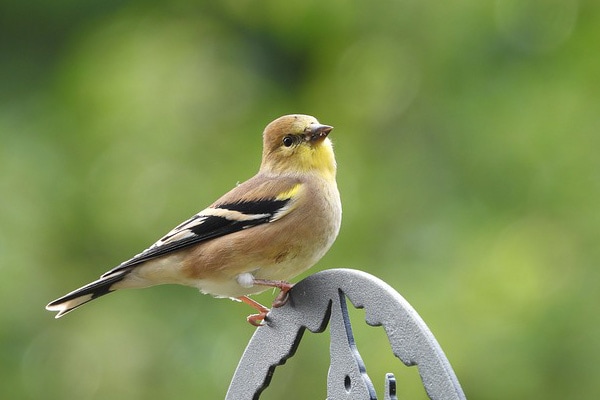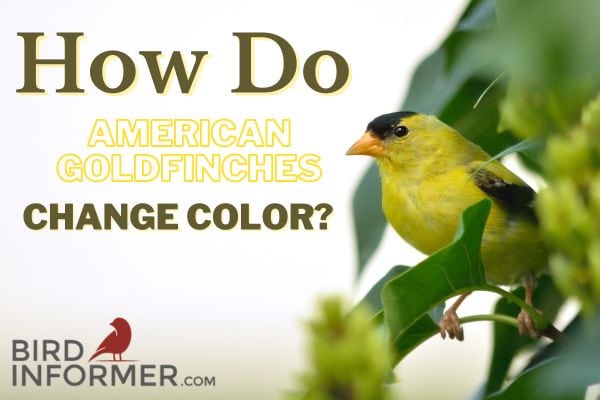Contents
- The Annual Plumage Cycle of the American Male Goldfinch
- Biology 101: Color Changes of the American Goldfinch during the Fall and Winter Seasons
- Birds That Change Colors
- The Reason Goldfinches Develop Bright Yellow Plumage
- Sexual Dysmorphism: How It Relates to the American Goldfinch
- What Causes the American Goldfinch to Turn Bright Yellow?
Are you trying to learn more about American goldfinches and their ability to change colors? You might want to learn how it’s possible, whether it happens, and have other important related questions. We’ll answer your questions and much more below.
American goldfinches change color in summer and winter. Their bright yellow feathers are replaced by duller ones. New feathers come in individually, one by one, while they molt. Molting season happens twice per year. At winter’s end, their dull feathers are replaced by a new set of yellow feathers.
If you’re hoping to discover further information about the changing colors of American goldfinches, you’ve definitely come to the right place. Throughout the rest of this article, I’d like to cover a few other related topics. They include:
- American male Goldfinch annual plumage cycle
- The American Goldfinch winter and fall colors
- The reason goldfinches develop bright yellow plumage
- What is sexual dysmorphism, and how does it relate to the American Goldfinch
- and other important topics
To find out more about this important topic, please continue reading to learn more.
The Annual Plumage Cycle of the American Male Goldfinch
According to Sibley Guide,
Molt is the process of further replacement. All birds do it; they have to grow new feathers once or twice a year to stay warm, dry, and airborne, and in many cases, they grow differently colored feathers at different seasons to match their surroundings or to impress others of their species.
Sibley Guides
As far as songbirds are concerned, the bulk of them undergo a complete molting at the end of the summer. Additionally, there are a number of different species that will also experience a partial molt in the spring by replacing some of their tail or wing feathers or even their body feathers.
The American Goldfinch follows the pattern mentioned above. Starting out in September and lasting four 6-8 weeks, the Goldfinch will molt its feathers. After the molding process takes place, it will have a completely brand-new set of feathers. At this time, those feathers will have drab-looking colors because the feathers that come in after the summer are a lot duller and less bright than the feathers that appear during the spring.
In fact, during the springtime, the male American goldfinch truly transforms its look and develops its plumage for breeding. During this time, their plumage becomes a bright golden yellow, but their tail and wing feathers stay the same with the duller colors of the late summer and early fall.
As September rolls around again, these birds will completely molt in their entirety, and the cycle continues twice a year.

Biology 101: Color Changes of the American Goldfinch during the Fall and Winter Seasons
The National Audubon Society tells us that:
The American Goldfinch undergoes such a radical transformation between seasons, it’s hard to believe that the gray-green birds of winter and the yellow-and-blackbirds of summer belong to the same species.
National Audobon Society
It’s very interesting to watch the transition of American goldfinches as they change their colors during the fall, winter, spring, and summer. If you’d like to see this transformation, you should hang up a bird feeder in your backyard so you can view the molting process right before your eyes.
Fall & Winter Molting Transition
In fact, if American goldfinches are coming to your bird feeder regularly during the months of September and October, you’ll have the opportunity to view the transition mentioned above. During this time of the year, gold finches will lose their bright golden color as their feathers molt and become replaced with new ones. The new feathers have a much duller look and appearance, which ultimately turns their beautiful bright yellow feathers into a dull gray color, which is part of the Goldfinch transformation process.
Spring & Summer Molting Transition
Homeowners also have the ability to experience this transition process in reverse. If they hang up a bird feeder in their backyard during the spring, they will also witness a partial molding process take place with the American goldfinches. During this time, they will molt and lose the majority of their feathers except for their tail and wing feathers. The dull gray feathers will totally disappear and become replaced with very bright yellow beautiful feathers.
By the time the summer rolls around in full swing, their gray wing and tail feathers turn dark black. This is an interesting transition to watch, to say the least, so if you’d like to witness it in person, it’s highly recommended that you install bird feeders and birdhouses in your backyard to attract these gorgeous songbirds to your property.
Birds That Change Colors
| Gold and black become dull gray | Color Changes |
|---|---|
| American Goldfinch | Blue, black, white, and yellow becomes dirty brown with streaks and underbelly patches |
| Yellow-rumped Warbler | Blue, black, white and yellow becomes dirty brown with streaks and underbelly patches |
| Common Loon | Black and white breeding plumage becomes gray and white winter plumage |
| Chipping Sparrow | Crisp white, black, brown, and rust colors become dull browns and subdued reds |
| Mallard | Summer plumage has bright green, reddish, black, and white feathers that become mottled brown in the fall |
The Reason Goldfinches Develop Bright Yellow Plumage
In the spring, it is a particularly interesting time to watch the American Goldfinch. Why? It’s during this time of year that its dull gray feathers turn into beautiful bright yellow breeding plumage.
Then everything changes again in September when the fall molting process once again begins. At this time, their beautiful golden feathers are also replaced. Their feathers become a very dull, very drab olive color. It’s a really unattractive mottled gray.
According to gardeninacity.com, “Birds like goldfinches and cardinals use bright colors to attract mates. But why don’t goldfinches keep their brooding plumage all year, as cardinals do?”
So, the Goldfinch will develop bright yellow plumage in an effort to attract a mate, which definitely makes sense because these male goldfinches look absolutely stunning with their golden yellow plumage. It doesn’t surprise me at all that female goldfinches would be attracted to this beautiful display.
But as previously mentioned, many people wonder why cardinals keep their breeding plumage all year long, yet American goldfinches do not.
Well, to put the question to bed once and for all, the reason cardinals maintain their breeding plumage all year is their breeding season itself. Cardinals have a much longer breeding season than the American Goldfinch. Their breeding season begins in February and lasts all way to September, which makes up the majority of the year.
On the other hand, the goldfinches do not remain within their breeding season for very long in comparison. Goldfinches are more about experiencing the breeding season and then moving on to other endeavors.
The Importance of Bright Yellow Plumage for Male American Goldfinches
Some people wonder if female goldfinches are shallow. They wonder if these female birds only like the brightest and most beautiful breeding plumage colors. What makes them so attracted to vivid yellow plumage?
The answer to this question is fairly simple, and it makes a great deal of sense. Believe it or not, the dazzling yellow plumage is more than just an attractive feature of male goldfinches during the breeding season. It’s actually an indicator of excellent health and great strength.
In fact, this is very true of red cardinals as well. The male cardinals, with all their feathers being the brightest plumage, tend to have the best success reproductively. They can keep their territories and hold them much better, and they are even better with parental care. So, these flashy birds also happen to be the greatest providers, and they even like to help rear the kids.

Sexual Dysmorphism: How It Relates to the American Goldfinch
According to the Times Union, “American goldfinches exhibit different color patterns in the feathers of males and females. In scientific terms, they exhibit ‘sexual dimorphism, ’with the term ‘dimorphism’ meaning ‘two forms.’ During the breeding season, male goldfinches are decked out in a stunning combination of shining yellow feathers with white-and-black trim. The females are more reserved mustard-brownish-yellow with white-and-black trim.”
So, the American Goldfinch experiences sexual dimorphism because the males have one particular look, which is explained in greater detail above. And the females have a much duller, darker, and much less attractive look then their male counterparts.
Is there a reason for these differences? Ultimately, the shiny yellow plumage of the male American Goldfinch shows that it is healthy, strong, and can do a great job of feeding its family while protecting the territory.
Males and females both change colors during the winter as well. The male loses its bright yellow feathers. The plumage is eventually converted to a brownish-olive color. Female American goldfinches lose their mustard brown-yellow colors, and their plumage becomes gray during the wintertime.
This is an interesting fact. Not only are American goldfinches sexually dimorphic, they are also seasonally dimorphic too. This means males and females both change colors during different seasons.
Interested In Having A Goldfinch As A Frequent Visitor?
Check out these awesome birdhouses that your favorite gold bird is sure to love! Click the button below!
What Causes the American Goldfinch to Turn Bright Yellow?
- Molting causes the American Goldfinch to shed its feathers during specific times of the year
- During the fall molting season, male American goldfinches will lose their magnificent yellow colors and their feathers will turn grayer and olive green
- During the fall molting season, female American goldfinches lose their mustard brown color to also develop dull gray plumage during the winter
- During the spring and summer seasons, male goldfinches will lose their gray plumage and their feathers will turn into beautiful vivid yellow plumage during breeding season
- During the spring and summer seasons, female goldfinches lose their gray feathers and their feathers turn a Dijon mustard color with browns mixed in

